

Report from the International Symposium of Byzantologists
NIŠ AND BYZANTIUM XXII
“Europe and the Balkans under Constantine’s Sign“
Dr Miša Rakocija
When Byzantium is mentioned, the first thing that comes to mind is the founder of the Byzantine Empire and the Christian faith, Emperor Constantine the Great, and Niš, where the Emperor Constantine was born who was later declared saint for Orthodox Christians. The International Symposium Nis and Byzantium that has been organized for 22 years by the City of Niš, the University of Niš, the Diocese of Niš and the Niš Cultural Center has greatly contributed to this.
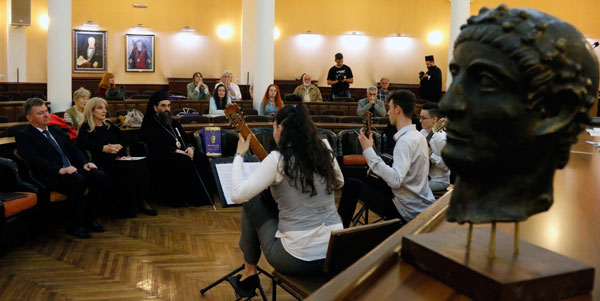
Opening of the symposium Niš and Byzantium XX, ceremonial hall of the University of Niš (Photo by M. Lavrenčić)
For 22 years, more than 900 distinguished Byzantologists from all over the world presented their papers from the lectern of the University of Niš. This resulted in the printing of 22 volumes of proceedings and one special edition on the occasion of the jubilee year 2013, a total of over 13,000 pages of new discoveries and knowledge about Byzantine art, civilization and the monumental heritage of the famous Niš city.
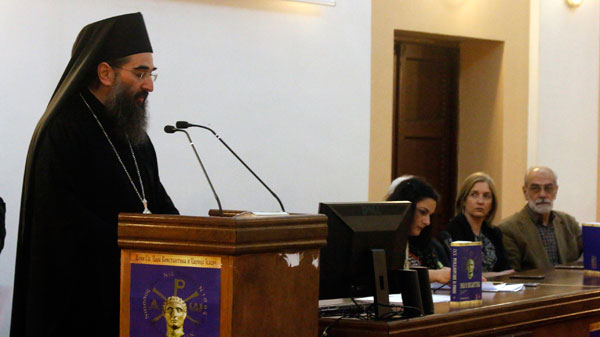
Opening of the symposium, blessing by Niš Bishop Arsenije (Photo by M. Lavrenčić)
That is why, after 22 years of organizing the symposium and regular printing of proceedings, it is understandable that the importance of the scientific meeting Niš and Byzantium is recognized by reputable institutes and notable universities from the Balkans and Europe, as well as the world. The city of the holy Emperor Constantine has gained an important place on the scientific, cultural, artistic and spiritual map of Europe. The birth of the man, the emperor and the saint Constantine the Great in Niš marked a turning point in the history of mankind. Without the emperor from Naisus, there would be no Christianity in Europe. Constantine the Great was born in present-day Serbia (Niš), proclaimed emperor in present-day England (York), with residence in present-day Germany (Trier), signed the Edict on Tolerance in present-day Italy (Milan), founded a new capital in present-day Turkey (Istanbul), so, as we can see, and he encompassed the whole of Europe with his life. Emperor Constantine the Great is Niš brand that should be exploited much more for the glory of our city and the unity of Europe. The presented discoveries of the participants of the Niš and Byzantium Symposium contribute a lot to this.
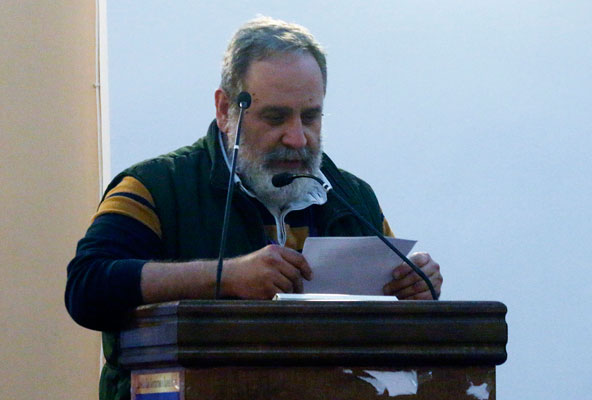
Prof. Dr. Janis Varalis (Volos), opening of the scientific meeting (Photo by M. Lavrenčić)
Niš, the hometown of the first Christian Emperor Constantine the Great, who laid the foundations of the Byzantine Empire, is destined to persevere on the path of establishing the truth about Byzantium. "Byzantium was the most cultural state of the Middle Ages and produced one of the greatest arts the world has seen," said Milan Kašanin, in 1927 and added: "Our medieval art is closely related to Byzantine, and what the world would think about Byzantine works of art it would think about ours as well".
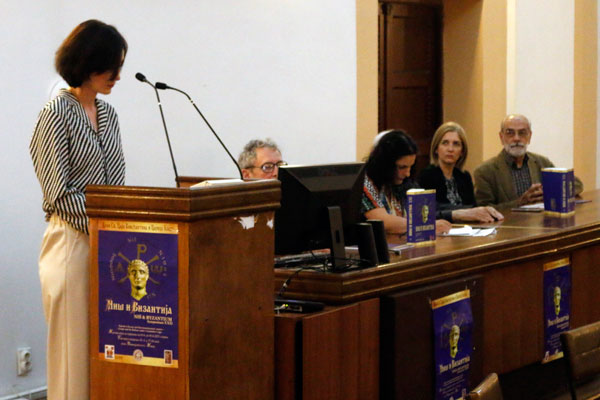
Prof. Dr Jasmina Šaranac, Ph.D., Promotion of Proceedings No XXI (Photo by M. Lavrenčić)
The words of Dante Alighieri from the end of the XIII century (1265 - 1321), who wished that Constantine had never been born, then the misunderstanding and all the misconceptions about Byzantium from the past, which brought immeasurable damage to the unity of Europe, are slowly being forgotten in the face of knowledge and science arguments that have been sent to the world from the lectern of the University of Niš for 22 years. This is of particular importance for the unity, artistic and spiritual orientation of contemporary Europe. Cultural rapprochement and artistic acquaintance lead to national unification, to the long-forgotten dream of Byzantine Greeks about one God and a single empire.
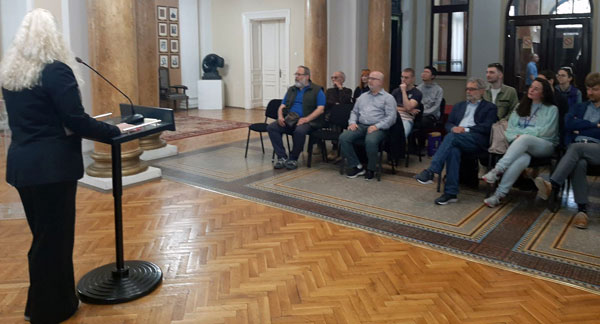
Reception at Niš City Hall, Mrs. Adriana Anastasov, the Member of Niš City Governement in charge of Culture
Observing Europe under Constantine’s Sign, better known as Christ’s monogram, we see that under that sign, Emperor Constantine united European nations culturally, civilizationally and spiritually. It is proven to be the most stable tripod on which the common future of Europe and its peoples should once again rest. A benevolent observer, who has knowledge, will notice that this unity lasts, and will last until God's will.
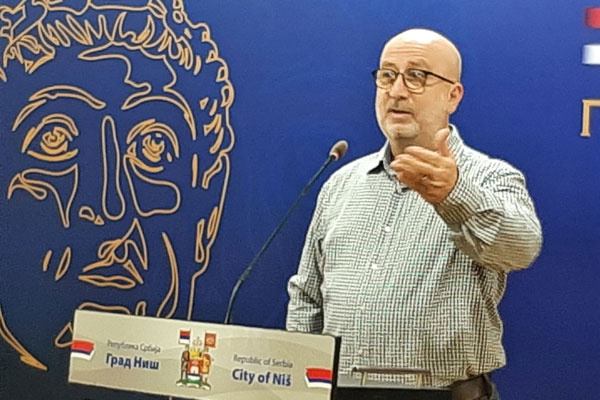
Reception at Niš City Hall, Speech by Prof. Dr Haluk Četikaja (Istanbul)
The longevity and great interest in the symposium Niš and Byzantium testifies to the comprehensive understanding of the importance of the works of St. Emperor Constantine for modern European civilization and implies the resurrection of Byzantine art and culture. Under the flag with the Constantine’s sign, with the faith of Christ in the heart and the name on the lips, the historical duration, civilizational and artistic continuity of Europe, the Balkans and Niš are ensured.
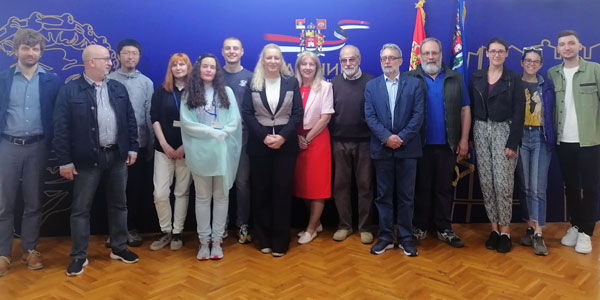
City of Niš Deputy Mayor Mrs. Dušica Davidović and City Of Niš Government Member for Culture Mrs. Adriana Anastasov
with the participants of the Niš and Byzantium Symposium
The Symposium Niš and Byzantium XXII began its work with the blessing of the Bishop of Niš Mr. Arsenije. After the opening speech by Dr Miša Rakocija, the attendees were greeted by the Deputy Mayor Mrs. Dušica Davidović. The vice-rector Prof. Dr Jovan Stepanović greeted the participants on the behalf of the University of Niš. The symposium was opened by Prof. Dr. Janis Varalis (University of Thessaly, Volos, Greece). Niš and Byzantium XXI Proceedings were presented by Prof. Dr. Jasmina Šaranac. The opening ceremony was enhanced by a trio of guitars played by the students of the Faculty of Arts in Niš.
The great interest of the scientific public in the Niš symposium was confirmed this year as well. 47 participants from 12 countries applied: Turkey, Austria, Greece, Russia, Italy, Bulgaria, Australia, Republika Srpska (Bosna and Herzegovina), North Macedonia, China, England and Serbia. Due to the limited time, 35 participants presented papers, while 12 participants were asked to apply next year. The joint dinner will be remembered as a place of inspired professional discussion, exchange of opinions, acquaintance and rapprochement.
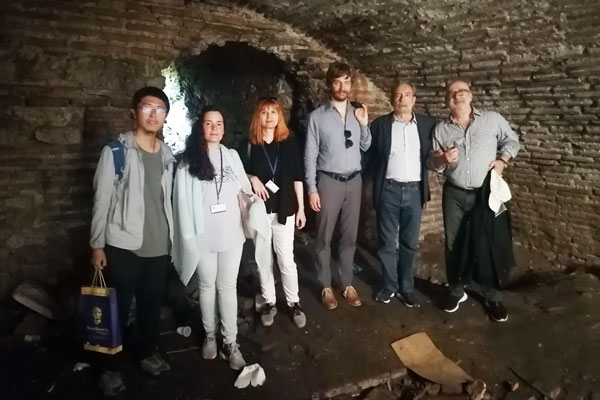
Tour of the Late Antique and Paleo-Byzantine heritage within the Niš Fortress:
ZiRan Guo (China), Anđela Gavrilović (Serbia), Majna Parijez (Republika Srpska), Marco Fasolio (Italy),
Miša Rakocija (Serbia), Dr. Haluk Cetikaya (Turkey)
At the end, the participants of the symposium were received in the City Hall with a suitable program by the Deputy Mayor Mrs. Dušica Davidović and the Member of Niš City Government for Culture Mrs. Adrijana Anastasov. On behalf of the participants, their impressions of the symposium were presented by prof. Dr. Janis Valaris (University of Thessaly, Volos, Greece) and Prof. Dr. Haluk Cetikaya (Istanbul, Turkey) pointing out the exceptional importance and scientific representativeness of the Niš Symposium of Byzantologists. After the ceremonial reception, the guests visited the Late Antique and Paleo-Byzantine heritage within the Niš Fortress.
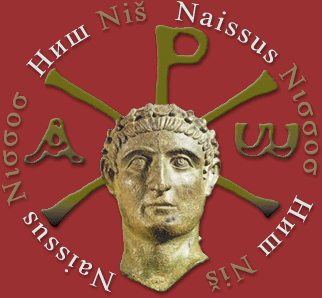
![]()


